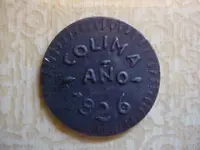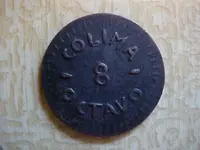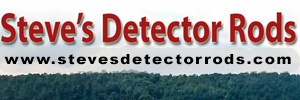I wanted to see if you could give me some information on some old coins that my mother has. She used to live in Tamaulipas, Mexico and said that a man sold the coins to her many years ago. There are nine coins in all, five are square / rectangle and the other four are circles. They are not silver and I don't think they could be gold because they look cooper but they seem to be coated with some kind of thin black paint. Here are their descriptions:
Squared coins:
1. front says, Villa de Colima 1853, back says ENR.
2. front says, ZAMATLAN 1835 1/8, back has nothing.
3. front says, HACIENDA EL CORTIJO 1853, back says PERES.
4. front says,ZAMATLAN 1835 1/8, back has nothing.
5. front says, UN OCTAVO 1835, back says HACIENDA MUNICIPAL DE OSTOTITLAN.
Round coins:
1. front says, TIZAPAN TLACO 1833 and has small circles, back has nothing.
2. front says 1/8 1824, has lines across it and small dots along the edge, the back has some grapes and the letter B on one side of the grapes and a T on the other, it also has lines across it and small dots along the edge.
3. The same as coin number two but thicker and bigger.
4. front says CONTU 1855 and has some type of stems under the date, back has 1/8 and and O on one side and a C on the other and some type of leaves under that.
I would really apreciate it if you could tell me where they are from or a little history of these types of coins and if they are worth anythig.
Thank you,
These "coins" are called hacienda tokens and were used to pay ranch workers for their labors. The families of the workers also lived on the ranch land and were essentially treated very much like medieval serfs. The tokens could only be used in the ranch company store and so the workers were tied completely to the ranch owners. The store sold general goods including food, tools, cooking utensils, clothing, tobacco, fuel oil, lamps, bedding, simple furniture and other essentials. The tokens come in many shapes and sizes and are made from brass, wood, white metal, copper and even bone. They are sometimes even painted as you have observed.
There are collectors of Hacienda Tokens and examples often appear in exonumia auctions. These tokens existed in other Latin American countries but the largest production of these interesting pieces are Mexican. The Hacienda system seems to be an important part of the economics of 19th century Mexico.
The tokens usually state the name of the hacienda or ranch a denomination (they didn't use Peso or centavo as these were official National designations). The term "Octavo" or 1/8 was a fractional token of what ever the "peso" denomination was called. I've seen, for example, "Cinco Mecates Chapeo" as a token denomination....translation Five ? Ropes. "Mecates" is the a Spanish word for rope or cord....Chapeo

...There is a Mexican game called Chapas which is a coin game....'could translate as 5 Ropes. The point is that the denominations were made up by the Ranch owners and they pegged the company store prices in tokens to a relationship to the national currency.
Values depend on the rarity of the item in the market place and the current collector interest. Prices range from a dollar or so to more than $100.
From:
http://www.coinsite.com/content/cdanswers/cdarchive12.asp




 ...There is a Mexican game called Chapas which is a coin game....'could translate as 5 Ropes. The point is that the denominations were made up by the Ranch owners and they pegged the company store prices in tokens to a relationship to the national currency.
...There is a Mexican game called Chapas which is a coin game....'could translate as 5 Ropes. The point is that the denominations were made up by the Ranch owners and they pegged the company store prices in tokens to a relationship to the national currency.